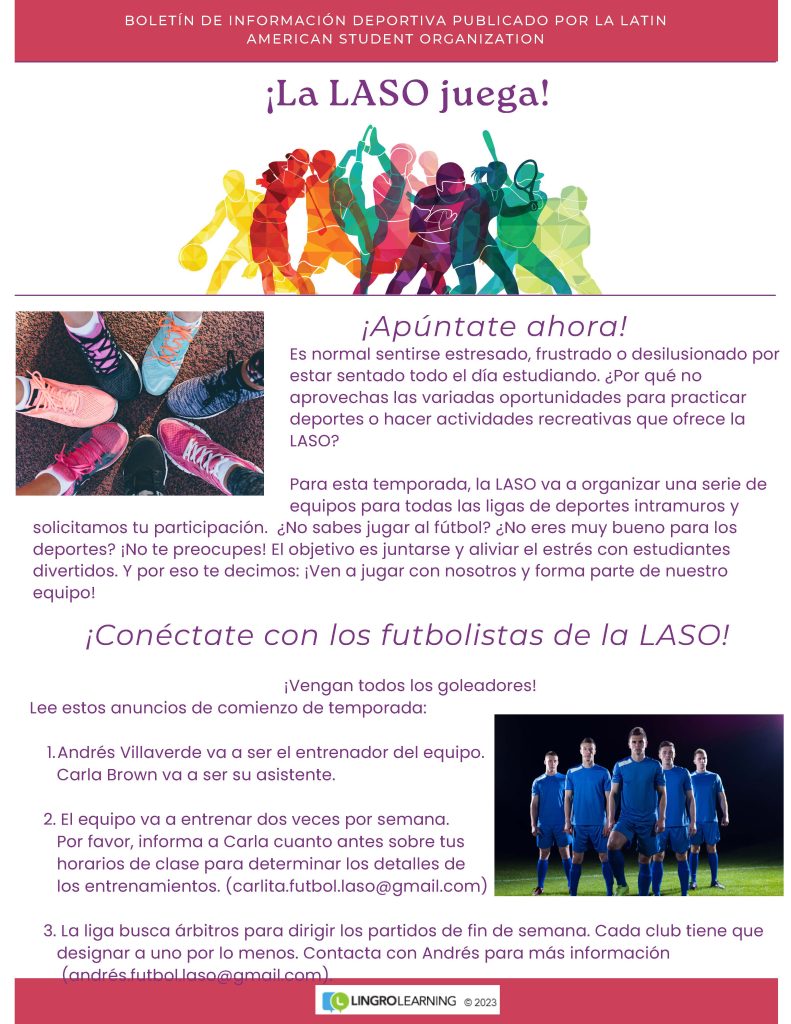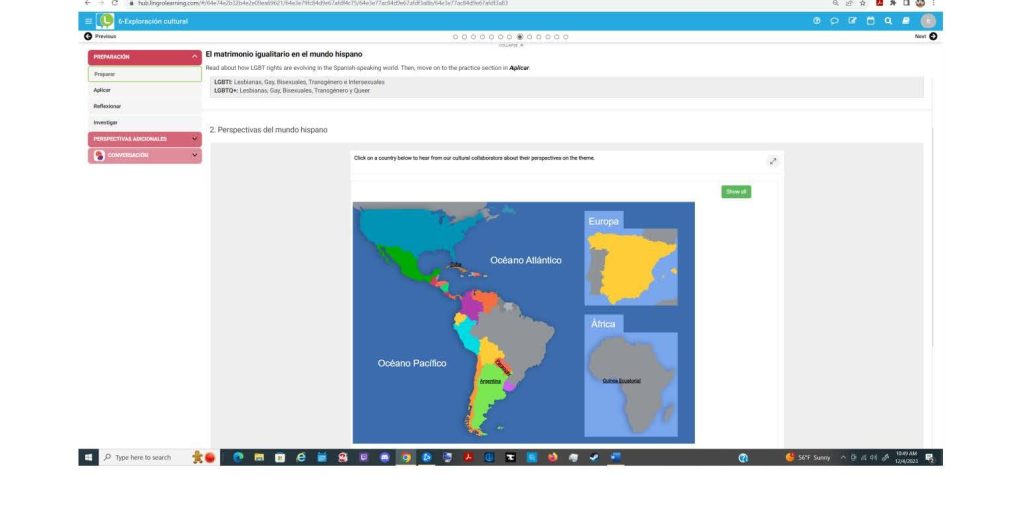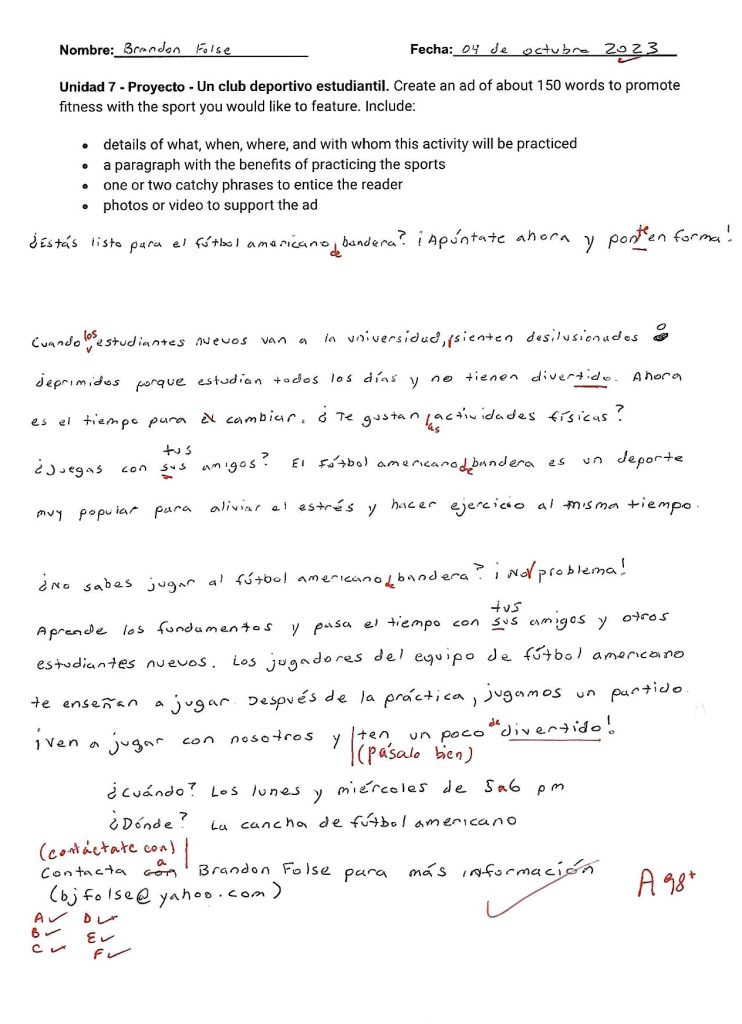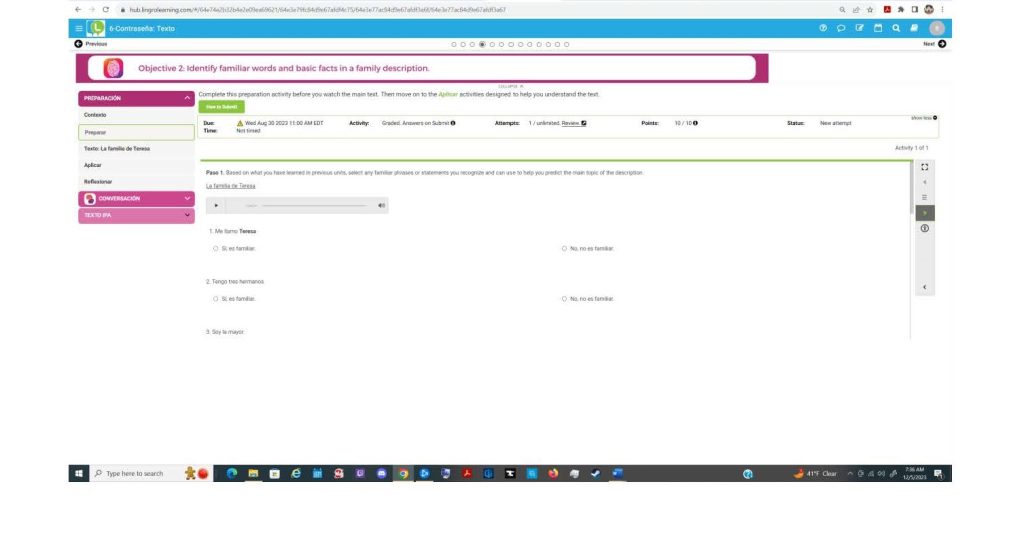Exploring Culture
The exercises that helped me to have a better understanding of cultural perspectives of those in Spanish-speaking countries were the Exploración Cultural sections throughout the LingroLearning course of study. Within these sections, students were given the cultural perspective on different topics and concepts we learned about, offering us a differing view than what we may be used to.
Because I am retired from the military, I consider myself a true world traveler. I have had the opportunity to explore many different countries and experience different cultures throughout my life. One thing I was always taught was to respect other cultures, even if it is different than my own. Because of this, I am always open-minded and understanding of different customs; a lot of stereotypes I may have had about other countries were wiped away during my military career.
With that, I can say that the things we learned in class didn’t surprise me. However, I appreciated the glimpse into cultural norms and traditions in the Spanish-speaking world.
Engaging in Communities
I believe that it is very important to engage in the community of the countries you visit. When you leave America and see other countries, you really get a sense of what people outside of our country deal with. Taking a walk off the beaten tourism path will really open up your eyes.
I was involved with many community outreach projects while on deployments in my Naval career. The Navy really stresses the importance of spreading goodwill to the people of foreign countries it visits. It is important to spread good will and help those in need, and I appreciated that those types of things were organized when we ported in other countries. I have also continued to pitch in and help when I can in my post-Navy life. My real estate brokerage, OWN Real Estate, participated in the 2023 Polar Plunge. We collectively raised over $25,000 that went directly to funding activities for Special Olympics Virginia Athletes.

Interpersonal Communication
As expected, the amount of time spent speaking Spanish definitely ramped up in Spanish 102. Overall, I really enjoyed this because it forced me to get outside of my comfort zone. It is funny to me that students take a foreign language course but are afraid or embarrassed to speak in front of others. Throughout the semester, our teacher put us into groups to complete various speaking exercises in order to get us speaking Spanish. However, the most in-depth speaking exercise was Talkabroad. Students were required to schedule two different 15 minute conversations with a native Spanish speaker, topics of which were selected by our teacher.
Looking back on these assignments, I can really see how far I’ve come as a Spanish speaker. Every speaking exercise I was assigned in class was enjoyable and easy due to not being required to have long conversations. Talkabroad, though, was very different due to the length of time required to talk. During the first conversation, I found myself saying phrases and sentences that popped into my head because I was very nervous and anxious. The conversation did not have a natural flow to it. By the time the second assignment was due, I was determined to make that assignment feel more natural to me. Going over my vocabulary and notes prior to my second conversation set me up for success.
Presentational Speaking
I believe that what I wrote in the previous section applies to this section as well. In many ways, speaking to others in small groups offered the same challenges as having to repeat those conversations in front of the entire class. Because the two are not much different, the solution of getting out of my own way to practice will help me better understand a new language and get over the fear of “sounding stupid.”
I discovered that practice was the key to success. It is not enough to just complete the assignments. I really had to put in extra time to go over vocabulary and repeat lessons in Lingrolearning in order to reinforce what I learned.
Presentational Writing
Two PROYECTOS that we were assigned during the course were writing assignments. Students were given a subject and were required to write about them. This was a huge test of grammar and noun-verb relationships.
It really forced me to study so that I did not data dump information after learning it. Even though each test had a stacking effect, they didn’t get easier. This was due to the fact that each test offered an appropriate level of difficulty. Understanding how to conjugate verbs and noun-verb relationships definitely helped me to excel in these tests. As I progress in my learning of Spanish and my vocabulary grows, it will be imperative that I continue to review what I have already learned so that I continue forward progression.
Interpretive Listening
Throughout the LingroLearning experience, students were presented with several listening exercises. Some required us to listen to a native speaker as he or she shares their experience on a particular subject. Others had students listen to a sentence in order to figure out what the subject was based on the verb conjugation.
The most challenging thing was the perceived speed at which the speakers were speaking. To me, it seemed to speed up this semester versus the previous. It was a good example of cadence from a Spanish-speaker. I wasn’t able to catch everything on the first listen, so I had to listen to these several times to extract the needed material. I really enjoyed these exercises because I was able to hear a real-speed conversation. It reinforced the learned material because, even though there were terms included that hadn’t been taught, I was able to get the main idea of the conversations to understand the context of what was being spoken. This built my confidence in that it showed me that I am learning and understanding the materials taught.
Interpretive Reading
An example of interpretive reading that was used in this semester was the flyer La Laso Juega in Unit 7. Students were required to read the flyer and answer questions about it.

When I first read this, I really skimmed the document for words I knew in order to understand the context of the entire flyer. The challenge was deriving context not knowing or understanding many of the words. Consulting my Spanish dictionary helped me to piece the information together. This flyer helped to bring together concepts newly learned, as well as reinforced what I had already learned. This assignment also made me realize that I am a long way from knowing every word, but I do know enough to understand the context. This makes me more confident as a Spanish speaker.



